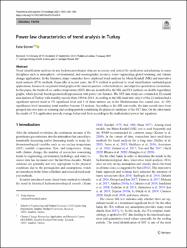| dc.contributor.author | Şişman, Eyüp | |
| dc.date.accessioned | 2021-10-19T08:59:46Z | |
| dc.date.available | 2021-10-19T08:59:46Z | |
| dc.date.issued | 2021 | en_US |
| dc.identifier.citation | Şişman, E. (2021). Power law characteristics of trend analysis in Turkey. Theoretical and Applied Climatology, 143(3-4), 1529-1541. https://dx.doi.org/10.1007/s00704-020-03408-9 | en_US |
| dc.identifier.issn | 0177-798X | |
| dc.identifier.issn | 1434-4483 | |
| dc.identifier.uri | https://dx.doi.org/10.1007/s00704-020-03408-9 | |
| dc.identifier.uri | https://hdl.handle.net/20.500.12511/8466 | |
| dc.description.abstract | Trend identification analyses in any hydrometeorological data are necessary and critical for predictions and planning in many disciplines such as atmospheric, environmental, and oceanographic sciences; water engineering; global warming; and climate change applications. In the literature, many researches have employed trend analyses by Mann-Kendall (MK) and innovative trend analysis (ITA) methods. Especially in recent years, the ITA method is preferred in trend identification methodological applications, because it can present trend graphs with visual inspection, verbal inferences, and objective quantitative calculations. In this paper, the trends of sea surface temperature (SST) data are identified by the MK and ITA methods on double logarithmic graphs, which provide fractal geometrical appearances with power law features. The SST data trends are evaluated at 22 coastal area stations of Turkey with monthly records from 1969 to 2014. According to the MK trend test, only 6 of the 22 stations had a significant upward trend at 5% significant level and 4 of these stations are in the Mediterranean Sea coastal area. At 10% significance level increasing trend numbers become 14 stations. According to the MK test results, the data records have been grouped into two parts as warming and cooling periods considering the physical conditions of the SST data. On the other hand, the results of ITA application provide average behavioral form according to the mathematical power law equations. | en_US |
| dc.language.iso | eng | en_US |
| dc.publisher | Springer Wien | en_US |
| dc.rights | info:eu-repo/semantics/embargoedAccess | en_US |
| dc.subject | Turkey | en_US |
| dc.subject | Trend Analysis | en_US |
| dc.subject | Power Law | en_US |
| dc.title | Power law characteristics of trend analysis in Turkey | en_US |
| dc.type | article | en_US |
| dc.relation.ispartof | Theoretical and Applied Climatology | en_US |
| dc.department | İstanbul Medipol Üniversitesi, Mühendislik ve Doğa Bilimleri Fakültesi, İnşaat Mühendisliği Bölümü | en_US |
| dc.department | İstanbul Medipol Üniversitesi, Rektörlük, İklim Değişikliği Araştırmaları Araştırma Merkezi (İKLİMER) | en_US |
| dc.authorid | 0000-0003-3696-9967 | en_US |
| dc.identifier.volume | 143 | en_US |
| dc.identifier.issue | 3-4 | en_US |
| dc.identifier.startpage | 1529 | en_US |
| dc.identifier.endpage | 1541 | en_US |
| dc.relation.publicationcategory | Makale - Uluslararası Hakemli Dergi - Kurum Öğretim Elemanı | en_US |
| dc.identifier.doi | 10.1007/s00704-020-03408-9 | en_US |
| dc.identifier.wosquality | Q2 | en_US |
| dc.identifier.scopusquality | Q2 | en_US |


















